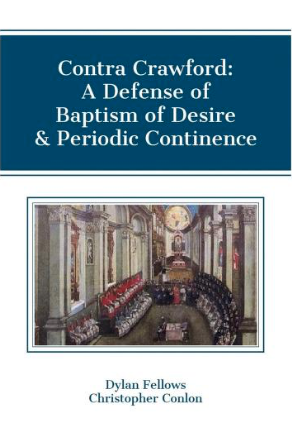Compelling, orthodox, easy to read!
A New Book defending Baptism of Desire and Blood:
Contra Crawford: A Defense of Baptism of Desire & Periodic Continence
by Dylan Fellows and Christopher Conlon
The sedevacantist laymen Dylan Fellows and Christopher Conlon are the authors of a new book defending the Catholic position on baptism of desire and baptism of blood as capable of supplying the sanctifying grace of the sacrament of baptism. This Church doctrine has been denied by a number of confused souls both inside and outside of Sedevacantism, especially in the United States, in the last few decades.
The name that is commonly (although not quite correctly) given to this erroneous denial is “Feeneyism”, because the first major figure to hold that those who die with the baptism of desire or blood will nevertheless go to hell was the Jesuit Fr. Leonard Feeney (1897-1978) in the 1940s. On Feb. 12, 1953, Pope Pius XII excommunicated Fr. Feeney for grave disobedience, after Feeney had persistently refused to obey the order to travel to Rome (all expenses paid) to appear before the Holy Office to explain his doctrine (see Acta Apostolicae Sedis 45 [1953], p. 100).
 The title of Fellows’ and Conlon’s book is Contra Crawford because what occasioned it was a new controversy about baptism of blood and desire stoked by the Rev. Mr. Dominic Crawford (pictured left as a seminarian in 2012), to whom it is a direct rejoinder. Crawford was an ordained transitional deacon in the sedevacantist Congregation of Mary Immaculate Queen (CMRI) before leaving the order in late 2016 or early 2017. The Superior General, Bp. Mark Pivarunas, had challenged the deacon on his errors, giving him 18 direct questions to answer. This he did, first, in a 14-page response, and later, in a more comprehensive booklet of 57 pages. Complete scans of all three of these documents — His Excellency’s challenge and Crawford’s two sets of replies — are included as appendices in Fellows’ and Conlon’s Contra Crawford. This gives the reader the full picture and ensures that everyone can see objections and replies in their full and original context.
The title of Fellows’ and Conlon’s book is Contra Crawford because what occasioned it was a new controversy about baptism of blood and desire stoked by the Rev. Mr. Dominic Crawford (pictured left as a seminarian in 2012), to whom it is a direct rejoinder. Crawford was an ordained transitional deacon in the sedevacantist Congregation of Mary Immaculate Queen (CMRI) before leaving the order in late 2016 or early 2017. The Superior General, Bp. Mark Pivarunas, had challenged the deacon on his errors, giving him 18 direct questions to answer. This he did, first, in a 14-page response, and later, in a more comprehensive booklet of 57 pages. Complete scans of all three of these documents — His Excellency’s challenge and Crawford’s two sets of replies — are included as appendices in Fellows’ and Conlon’s Contra Crawford. This gives the reader the full picture and ensures that everyone can see objections and replies in their full and original context.
The book, which was first released in August of this year, is available for free in electronic format or for a modest price in paperback:
- Contra Crawford by Fellows & Conlon (PDF Download)
- Contra Crawford by Fellows & Conlon (Paperback)
What makes Contra Crawford particularly powerful is that at the outset it provides an overview of how the Church teaches the faithful, what Catholics have an obligation to accept, and what infallibility is and when it enters into the picture. This is crucial to understand because the Feeneyite error begins as an error in method, one that tragically distorts how the Church was commissioned by Christ to teach her children.
Incidentally, some additional good resources on the topic of baptism of blood and desire are:
- “Salvation Outside the Church?”, Chapter XI in Michael Davies – An Evaluation (1989, 2015) by John S. Daly
- “Extra Ecclesiam Nulla Salus” (1971), pp. 190-215 of The Robber Church (1998) by Patrick Henry Omlor
- “Baptism of Desire and Theological Principles” (2000) by Fr. Anthony Cekada
- Sources of Baptism of Blood & Baptism of Desire (2014) by Christopher P. Conlon
- Baptism of Desire or Blood: A Defense in Brief Ad Majorem Dei Gloriam (2012) by Steven Speray
- The Catholic Church and Salvation (1958) by Mgr. Joseph Clifford Fenton
- The Necessity of the Church for Salvation (1960) by Fr. John King
- TRADCAST 004 by Novus Ordo Watch
- BaptismOfDesire.com
Another error promoted by the Rev. Crawford (one that is likewise shared by some other sedevacantists and non-sedevacantists) is the idea that periodic continence (aka the rhythm method) among married couples is intrinsically evil and therefore never permitted. Yet the truth is that ever since the question first came up in the nineteenth century, the Church has consistently permitted its use under certain restrictive circumstances. Contra Crawford traces the history of the Church’s magisterial response to the question, explains the moral principles behind it, and shows that arguments against it are unsound and are based on an incomplete and distorted view of Catholic teaching on the subject. The authors also make clear that the licit practice of periodic continence is not the same thing as the common Novus Ordo practice of “Natural Family Planning”, which they point out “is in violent contradiction to Pope Pius XII’s guidelines” (p. 86).
Overall, Contra Crawford makes for a very pleasant and easy read. The authors explain for the average layman the necessary theological concepts sufficiently but without dwelling on them more than is necessary. This ensures that the book is neither overly complex nor woefully superficial; it is neither simplistic nor insufferably dry. More difficult-to-understand concepts are illustrated by means of examples the reader can relate to. Each chapter ends with a brief bullet-point summary to allow for a quick review of the material presented, and a bibliography at the end provides information for further reading.
It is thus with great pleasure and excitement that Novus Ordo Watch joins Bp. Mark Pivarunas in highly recommending Contra Crawford. The Catholic world owes a debt of gratitude to Dylan Fellows and Chris Conlon for this excellent work!
Please note: There will be no combox for this post. Since the issues discussed in Contra Crawford are somewhat peripheral to the overall mission of Novus Ordo Watch, and since we do not want to have to invest in the time and resources needed to moderate the endless debate this post is sure to trigger, there will be no comments at all permitted for this post.
Image source: archive.org (screenshot) / cmri.org
License: Fair use / fair use





